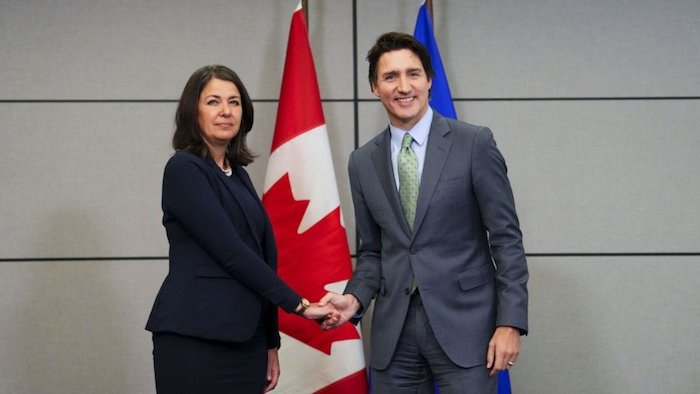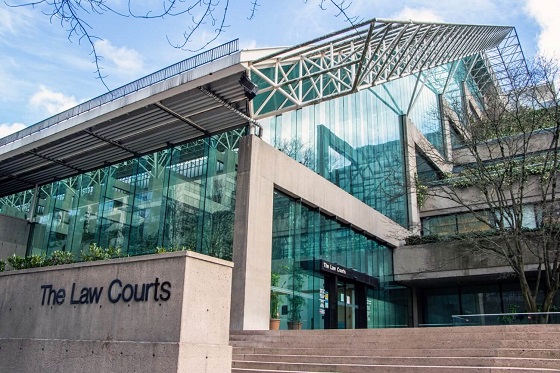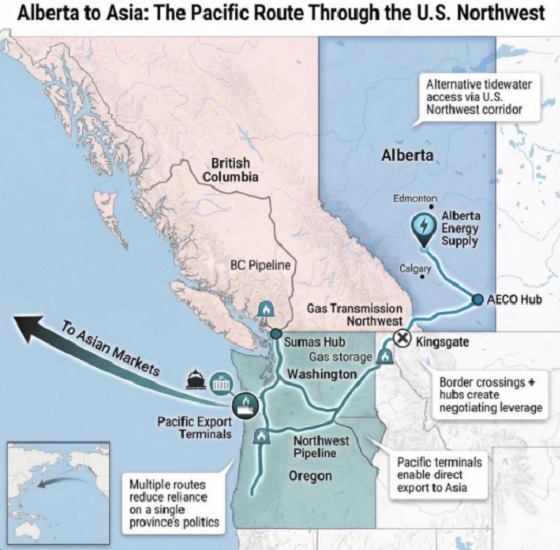Alberta
The Awed Couple: Can Ottawa Force Alberta To Stay In Its Lane?

Fact: Alberta and Saskatchewan were to enter Confederation in 1905 as a province named Buffalo. But Sir Wilfrid Laurier feared a landmass that big would threaten the domination of Quebec and Ontario in Canada. And so Buffalo was split into the two provinces we know today.
Of all the riddles that make up Canada’s current prime minister one of the most intriguing is how the grandson of a man, Charles-Émile Trudeau, who made his fortune in Montreal gas stations is now hellbent on destroying the same industry.
In this obsession to end fossil fuels, Trudeau does have the company of many other heirs to fortunes created by oil and its products. The ranks of Green NGOs and political movements are thick with names like Rockefeller, Getty, Morgan, Flagler and more, heirs with a guilty conscience about perceived climate-change destruction.
But while most of these families have chosen discreet roles in their quest, Trudeau’s climate infatuation has propelled him to prime minister of Canada since 2015. In that time “Sunny Ways” Justin has obsessively pursued his goal of transitioning Canada from the fossil-fuel giant to an imagined Shangri-la of gentle breezes and warm sunshine.
Nothing can shake him of his messianic role as saviour of the Frozen North. Likewise, no public disgrace or controversy can shake his loyal supporters who supported his father in the same manner. Buttressed by the lapdog NDP caucus he spouts buckets of enviro-nonsense to a docile media (which he has bribed to stay quiet).
Because subtlety is not a strong suit he even named a former Greenpeace zealot and convicted felon as his Environment minister. Which has naturally put him directly at odds with that portion of the country that exploits fossil fuels and (don’t tell anybody) floats the boat of federal budgets.
So when Justin proposed a Canadian Sustainable Jobs Act to turn energy workers into code writers and social workers by 2035 there was a degree of pushback amongst those who would lose their livelihoods. That plan was revealed last week by EnerCan (who makes up this dreck?) minister Jonathan Wilkinson.
Promising to convert Calgary’s public transit to all-electric, Wilkinson (former leader of the New Democratic Party‘s youth wing in Saskatchewan) proposed the ‘Sustainable Jobs Act’ advisory council that will provide the federal government with recommendations on how to support the Canadian workforce during transition to a ‘net-zero economy.” You can guess who’ll be on the advisory council, but don’t count on any Ford F-150 drivers.

Enter Danielle Smith, newly re-elected premier of Alberta. Smith and her advisors have declared as unworkable the federal government’s unilateral prescription for a carbon-neutral society by 2050. While they recognize the need for transition the Alberta solution is predictably less draconian than Trudeau’s Pol Pot prescription for moving the population back to a more bucolic lifestyle.
Specifically, Alberta wants “to achieve a carbon-neutral energy economy by 2050, primarily through investment in emissions-reduction technologies and the increased export of Alberta LNG to replace higher-emitting fuels internationally.” (Presumably Alberta will be joined by Saskatchewan in this pushback.)
Then came the hammer. “As the development of Alberta’s natural resources and the regulation of our energy sector workforce are constitutional rights and the responsibility of Alberta, any recommendations provided by this new federal advisory council must align with Alberta’s Emissions Reduction and Energy Development Plan.”
Translation: Federal legislation has to be in synch with provincial plans, not the other way around. In short, try to impose some Michael Mann fantasy on the province and it’s a no-go. Don’t like it? See you in court. In Alberta. Not Ottawa.
Will this constitutional gambit work? While Smith’s mandate from the recent election is hardly rock-solid, she does have the benefit of time in her four-year term. Trudeau has no such luxury, and launching a court case in Alberta would likely stretch past his mandate ending next year. Yes, the impertinence of Alberta would play well with his base in the 514/613/416. But let’s be honest, they are voting Trudeau even if he (in the words of Donald Trump) grabs them by the privates.
One thing you can be assured of when it comes to the PM. He will not be forcing any Canadian Sustainable Jobs Act on the Ontario auto industry to aid its transition to EV vehicles. There will be no helpful suggestions on the death of the automobile for the new mutlti-billion dollar VW battery plants cashing federal cheques in Windsor. He knows his voting base won’t buy it. But those Alberta saps?
The telling impact of this jurisdictional fight will be where Trudeau’s rival, Pierre Poilievre, comes down on the transition issue. With his election depending on the swaths of voters in the GTA shoulder ridings— where Trudeau’s mooting about crybaby Alberta will get a full airing— does he lend his support to Smith’s pushback?

Put simply, is backing Alberta sovereignty in the oil patch a vote-loser for a party still looking past “Hate Trudeau” as an election platform? You could see Poilievre rationalizing that he’ll get the seats in the West no matter what, so why not leave Trudeau to wrassle the Alberta bear alone?
Risky for sure. But if he gets the PMO seat in 2024 Poilievre can always play kiss-and-make-up later with Smith and her government. Can’t wait.
Sign up today for Not The Public Broadcaster newsletters. Hot takes/ cool slants on sports and current affairs. Have the latest columns delivered to your mail box. Tell your friends to join, too. Always provocative, always independent. https://share.hsforms.com/16edbhhC3TTKg6jAaRyP7rActsj5
Bruce Dowbiggin @dowbboy is the editor of Not The Public Broadcaster A two-time winner of the Gemini Award as Canada’s top television sports broadcaster, he’s a regular contributor to Sirius XM Canada Talks Ch. 167. Inexact Science: The Six Most Compelling Draft Years In NHL History, his new book with his son Evan, was voted the seventh-best professional hockey book of all time by bookauthority.org . His 2004 book Money Players was voted sixth best on the same list, and is available via http://brucedowbigginbooks.ca/book-personalaccount.aspx
Alberta
Alberta project would be “the biggest carbon capture and storage project in the world”

Pathways Alliance CEO Kendall Dilling is interviewed at the World Petroleum Congress in Calgary, Monday, Sept. 18, 2023.THE CANADIAN PRESS/Jeff McIntosh
From Resource Works
Carbon capture gives biggest bang for carbon tax buck CCS much cheaper than fuel switching: report
Canada’s climate change strategy is now joined at the hip to a pipeline. Two pipelines, actually — one for oil, one for carbon dioxide.
The MOU signed between Ottawa and Alberta two weeks ago ties a new oil pipeline to the Pathways Alliance, which includes what has been billed as the largest carbon capture proposal in the world.
One cannot proceed without the other. It’s quite possible neither will proceed.
The timing for multi-billion dollar carbon capture projects in general may be off, given the retreat we are now seeing from industry and government on decarbonization, especially in the U.S., our biggest energy customer and competitor.
But if the public, industry and our governments still think getting Canada’s GHG emissions down is a priority, decarbonizing Alberta oil, gas and heavy industry through CCS promises to be the most cost-effective technology approach.
New modelling by Clean Prosperity, a climate policy organization, finds large-scale carbon capture gets the biggest bang for the carbon tax buck.
Which makes sense. If oil and gas production in Alberta is Canada’s single largest emitter of CO2 and methane, it stands to reason that methane abatement and sequestering CO2 from oil and gas production is where the biggest gains are to be had.
A number of CCS projects are already in operation in Alberta, including Shell’s Quest project, which captures about 1 million tonnes of CO2 annually from the Scotford upgrader.
What is CO2 worth?
Clean Prosperity estimates industrial carbon pricing of $130 to $150 per tonne in Alberta and CCS could result in $90 billion in investment and 70 megatons (MT) annually of GHG abatement or sequestration. The lion’s share of that would come from CCS.
To put that in perspective, 70 MT is 10% of Canada’s total GHG emissions (694 MT).
The report cautions that these estimates are “hypothetical” and gives no timelines.
All of the main policy tools recommended by Clean Prosperity to achieve these GHG reductions are contained in the Ottawa-Alberta MOU.
One important policy in the MOU includes enhanced oil recovery (EOR), in which CO2 is injected into older conventional oil wells to increase output. While this increases oil production, it also sequesters large amounts of CO2.
Under Trudeau era policies, EOR was excluded from federal CCS tax credits. The MOU extends credits and other incentives to EOR, which improves the value proposition for carbon capture.
Under the MOU, Alberta agrees to raise its industrial carbon pricing from the current $95 per tonne to a minimum of $130 per tonne under its TIER system (Technology Innovation and Emission Reduction).
The biggest bang for the buck
Using a price of $130 to $150 per tonne, Clean Prosperity looked at two main pathways to GHG reductions: fuel switching in the power sector and CCS.
Fuel switching would involve replacing natural gas power generation with renewables, nuclear power, renewable natural gas or hydrogen.
“We calculated that fuel switching is more expensive,” Brendan Frank, director of policy and strategy for Clean Prosperity, told me.
Achieving the same GHG reductions through fuel switching would require industrial carbon prices of $300 to $1,000 per tonne, Frank said.
Clean Prosperity looked at five big sectoral emitters: oil and gas extraction, chemical manufacturing, pipeline transportation, petroleum refining, and cement manufacturing.
“We find that CCUS represents the largest opportunity for meaningful, cost-effective emissions reductions across five sectors,” the report states.

Fuel switching requires higher carbon prices than CCUS.
Measures like energy efficiency and methane abatement are included in Clean Prosperity’s calculations, but again CCS takes the biggest bite out of Alberta’s GHGs.
“Efficiency and (methane) abatement are a portion of it, but it’s a fairly small slice,” Frank said. “The overwhelming majority of it is in carbon capture.”

From left, Alberta Minister of Energy Marg McCuaig-Boyd, Shell Canada President Lorraine Mitchelmore, CEO of Royal Dutch Shell Ben van Beurden, Marathon Oil Executive Brian Maynard, Shell ER Manager, Stephen Velthuizen, and British High Commissioner to Canada Howard Drake open the valve to the Quest carbon capture and storage facility in Fort Saskatchewan Alta, on Friday November 6, 2015. Quest is designed to capture and safely store more than one million tonnes of CO2 each year an equivalent to the emissions from about 250,000 cars. THE CANADIAN PRESS/Jason Franson
Credit where credit is due
Setting an industrial carbon price is one thing. Putting it into effect through a workable carbon credit market is another.
“A high headline price is meaningless without higher credit prices,” the report states.
“TIER credit prices have declined steadily since 2023 and traded below $20 per tonne as of November 2025. With credit prices this low, the $95 per tonne headline price has a negligible effect on investment decisions and carbon markets will not drive CCUS deployment or fuel switching.”
Clean Prosperity recommends a kind of government-backstopped insurance mechanism guaranteeing carbon credit prices, which could otherwise be vulnerable to political and market vagaries.
Specifically, it recommends carbon contracts for difference (CCfD).
“A straight-forward way to think about it is insurance,” Frank explains.
Carbon credit prices are vulnerable to risks, including “stroke-of-pen risks,” in which governments change or cancel price schedules. There are also market risks.
CCfDs are contractual agreements between the private sector and government that guarantees a specific credit value over a specified time period.
“The private actor basically has insurance that the credits they’ll generate, as a result of making whatever low-carbon investment they’re after, will get a certain amount of revenue,” Frank said. “That certainty is enough to, in our view, unlock a lot of these projects.”
From the perspective of Canadian CCS equipment manufacturers like Vancouver’s Svante, there is one policy piece still missing from the MOU: eligibility for the Clean Technology Manufacturing (CTM) Investment tax credit.
“Carbon capture was left out of that,” said Svante co-founder Brett Henkel said.
Svante recently built a major manufacturing plant in Burnaby for its carbon capture filters and machines, with many of its prospective customers expected to be in the U.S.
The $20 billion Pathways project could be a huge boon for Canadian companies like Svante and Calgary’s Entropy. But there is fear Canadian CCS equipment manufacturers could be shut out of the project.
“If the oil sands companies put out for a bid all this equipment that’s needed, it is highly likely that a lot of that equipment is sourced outside of Canada, because the support for Canadian manufacturing is not there,” Henkel said.
Henkel hopes to see CCS manufacturing added to the eligibility for the CTM investment tax credit.
“To really build this eco-system in Canada and to support the Pathways Alliance project, we need that amendment to happen.”
Resource Works News
Alberta
Alberta Next Panel calls for less Ottawa—and it could pay off

From the Fraser Institute
By Tegan Hill
Last Friday, less than a week before Christmas, the Smith government quietly released the final report from its Alberta Next Panel, which assessed Alberta’s role in Canada. Among other things, the panel recommends that the federal government transfer some of its tax revenue to provincial governments so they can assume more control over the delivery of provincial services. Based on Canada’s experience in the 1990s, this plan could deliver real benefits for Albertans and all Canadians.
Federations such as Canada typically work best when governments stick to their constitutional lanes. Indeed, one of the benefits of being a federalist country is that different levels of government assume responsibility for programs they’re best suited to deliver. For example, it’s logical that the federal government handle national defence, while provincial governments are typically best positioned to understand and address the unique health-care and education needs of their citizens.
But there’s currently a mismatch between the share of taxes the provinces collect and the cost of delivering provincial responsibilities (e.g. health care, education, childcare, and social services). As such, Ottawa uses transfers—including the Canada Health Transfer (CHT)—to financially support the provinces in their areas of responsibility. But these funds come with conditions.
Consider health care. To receive CHT payments from Ottawa, provinces must abide by the Canada Health Act, which effectively prevents the provinces from experimenting with new ways of delivering and financing health care—including policies that are successful in other universal health-care countries. Given Canada’s health-care system is one of the developed world’s most expensive universal systems, yet Canadians face some of the longest wait times for physicians and worst access to medical technology (e.g. MRIs) and hospital beds, these restrictions limit badly needed innovation and hurt patients.
To give the provinces more flexibility, the Alberta Next Panel suggests the federal government shift tax points (and transfer GST) to the provinces to better align provincial revenues with provincial responsibilities while eliminating “strings” attached to such federal transfers. In other words, Ottawa would transfer a portion of its tax revenues from the federal income tax and federal sales tax to the provincial government so they have funds to experiment with what works best for their citizens, without conditions on how that money can be used.
According to the Alberta Next Panel poll, at least in Alberta, a majority of citizens support this type of provincial autonomy in delivering provincial programs—and again, it’s paid off before.
In the 1990s, amid a fiscal crisis (greater in scale, but not dissimilar to the one Ottawa faces today), the federal government reduced welfare and social assistance transfers to the provinces while simultaneously removing most of the “strings” attached to these dollars. These reforms allowed the provinces to introduce work incentives, for example, which would have previously triggered a reduction in federal transfers. The change to federal transfers sparked a wave of reforms as the provinces experimented with new ways to improve their welfare programs, and ultimately led to significant innovation that reduced welfare dependency from a high of 3.1 million in 1994 to a low of 1.6 million in 2008, while also reducing government spending on social assistance.
The Smith government’s Alberta Next Panel wants the federal government to transfer some of its tax revenues to the provinces and reduce restrictions on provincial program delivery. As Canada’s experience in the 1990s shows, this could spur real innovation that ultimately improves services for Albertans and all Canadians.
-

 Haultain Research2 days ago
Haultain Research2 days agoSweden Fixed What Canada Won’t Even Name
-

 Business2 days ago
Business2 days agoWhat Do Loyalty Rewards Programs Cost Us?
-

 Business1 day ago
Business1 day agoLand use will be British Columbia’s biggest issue in 2026
-

 Business24 hours ago
Business24 hours agoMainstream media missing in action as YouTuber blows lid off massive taxpayer fraud
-

 Business23 hours ago
Business23 hours agoStripped and shipped: Patel pushes denaturalization, deportation in Minnesota fraud
-

 Energy15 hours ago
Energy15 hours agoRulings could affect energy prices everywhere: Climate activists v. the energy industry in 2026
-

 International14 hours ago
International14 hours agoChina Stages Massive Live-Fire Encirclement Drill Around Taiwan as Washington and Japan Fortify
-

 Digital ID13 hours ago
Digital ID13 hours agoThe Global Push for Government Mandated Digital IDs And Why You Should Worry










